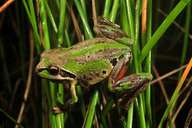|
Description
We need a species account! Contact us if you are interested in writing for AmphibiaWeb.
Distribution and Habitat
Country distribution from AmphibiaWeb's database: Australia
Eastern Australia. From mid Southeast Queensland to the northern Tablelands of New South Wales and central and southern coast of New South Wales. Also in the eastern corner of Victoria.
The extent of occurrence of the species is approximately 236400 km2.
Locally abundant.
Declines have been recorded in the Canberra region in the past 20 years.
Two subspecies are recognized (Barker et al 1995): L. v. verreauxii is known from sea-level to ca. 800 m within the range, while L. v. alpina is found at higher elevations and has a much more reduced distribution, which Osborne et al (1999) estimated at ca. 3,200 km2.
Life History, Abundance, Activity, and Special Behaviors
Common in a wide variety of habitats including coastal swamps and lagoons, wet and dry sclerophyll forest. Most often associated with permanent water, ie. ponds, dams, lakes, creeks and waterholes.
Calls year round. Males call from ground up to several meters from water or on vegetation near water. About 500 – 1000 eggs are laid in jelly clumps attached to submerged vegetation in ponds.
Trends and Threats
In 2004, IUCN Assessment annotated the species as remaining Least Concern due to its wide distribution, being locally abundant, and general habitat tolerance; however, it noted 'population trends' as declining.
General threats include drought and loss of habitat.
At the moment, this species range occurs in several protected areas and the high elevation subspecies L. v. alpina is listed as endangered by State and Nationally with many of its populations in National Parks.
Possible reasons for amphibian decline General habitat alteration and loss
Prolonged drought
Comments
This species was featured as News of the Week on 18 May 2020:
The capacity of Batrachochytrium dendrobatidis (Bd) to negatively impact amphibian diversity at the species and population level has been clear for decades, yet our understanding of Bd’s impact on amphibian genetic diversity remains unresolved. Banks et al (2020) compare SNP diversity in Bd-naïve alpine tree frog populations (Litoria verreauxii alpina) with populations exposed since the 1980s to help illuminate whether we should be concerned about the genetic viability of species that underwent major Bd-associated declines. Although most breeding adults in exposed populations still succumb to disease each year, Banks et al did not find significant differences in the genetic diversity of exposed and naïve groups. The study was limited by the few available naïve populations, but many frogs do manage to breed before they die, and juveniles can escape infection and provide a reservoir of genetic diversity. Individuals’ heterozygosity correlated with infection likelihood in exposed populations, so the authors suggest that more heterozygous frogs may generally contribute more to the next generation. Finally, like many species heavily impacted by Bd, this alpine frog species occurs in isolated, low-density populations. They finds little genetic exchange between these remnants, concluding that sustained isolation will result in the further structuring of these populations into the future. (Emma Steigerwald)
References
Barker, J., Grigg, G. C., and Tyler, M. J. (1995). A Field Guide to Australian Frogs. Surrey Beatty and Sons, New South Wales.
Cogger, H.G. (1992). Reptiles and Amphibians of Australia. Reed Books, New South Wales.
Hero, J.-M., Littlejohn, M., and Marantelli, G. (1991). Frogwatch Field Guide to Victorian Frogs. Department of Conservation and Environment, Victoria.
IUCN, Conservation International, and NatureServe. 2004. Global Amphibian Assessment. <www.globalamphibians.org>. Accessed on 14 February 2005.
Osborne, W. (1990). ''Declining frog populations and extinctions in the Canberra region.'' Bogong, 11(4), 4-7.
Originally submitted by: Jean-Marc Hero et. al. (first posted 2002-04-05)
Edited by: Jean-Marc Hero, Michelle Koo (2020-05-17)Species Account Citation: AmphibiaWeb 2020 Litoria verreauxii: Verreaux's Tree Frog <https://amphibiaweb.org/species/1315> University of California, Berkeley, CA, USA. Accessed Jun 9, 2025.
Feedback or comments about this page.
Citation: AmphibiaWeb. 2025. <https://amphibiaweb.org> University of California, Berkeley, CA, USA. Accessed 9 Jun 2025.
AmphibiaWeb's policy on data use.
|





 Map of Life
Map of Life